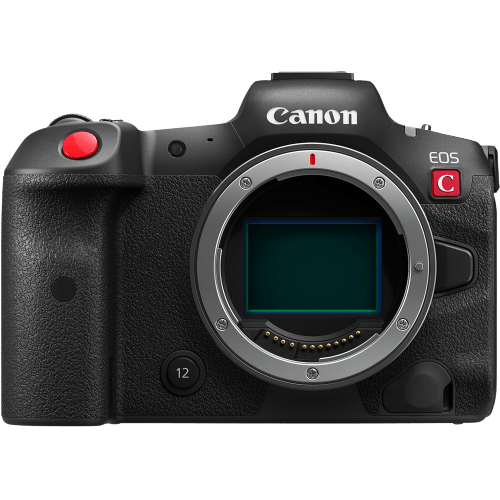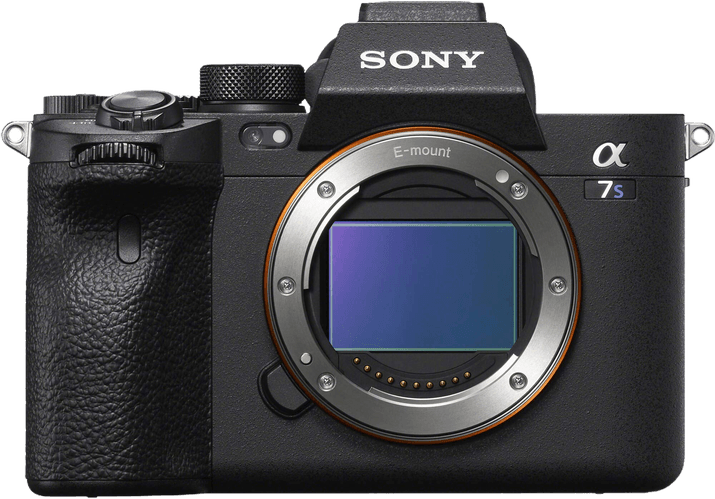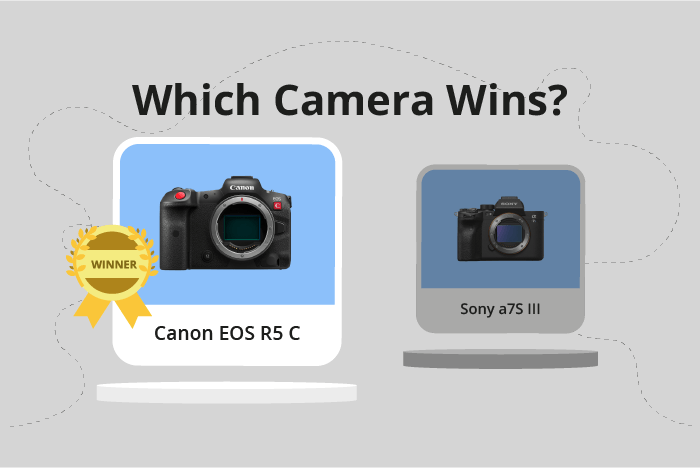Canon EOS R5 C vs Sony a7S III Comparison
Canon EOS R5 C

Sony a7S III

The Canon EOS R5 C outperforms the Sony a7S III with a score of 87/100 compared to 74/100. Both cameras are mirrorless and share some common specifications. They were announced in 2022 and 2020, with launch prices of $4499 and $3499, respectively.
The Canon EOS R5 C excels with its larger size (142 x 101 x 111mm) and heavier weight (770g / 1.70lbs), which may provide better stability and durability. On the other hand, the Sony a7S III has a smaller size (129 x 97 x 81mm) and lighter weight (699g / 1.54lbs), making it more portable and easier to handle.
Considering the specifications, the Canon EOS R5 C is a better camera with a higher score, while the Sony a7S III offers advantages in portability and a lower launch price. Both cameras cater to different needs and preferences, so choosing the right one depends on the user’s priorities.
Canon EOS R5 C vs Sony a7S III Overview and Optics
The Canon EOS R5 C outperforms the Sony a7S III in optics, scoring 88/100 compared to the Sony’s 69/100. Both cameras share some similarities in their specifications, such as having a CMOS sensor, full-frame sensor size, and image stabilization. Additionally, both cameras have their respective lens mounts: Canon RF for the EOS R5 C and Sony FE for the a7S III.
The Canon EOS R5 C excels with its 45 megapixels, significantly higher than the Sony a7S III’s 12.1 megapixels. This difference allows the Canon to capture more detail and produce higher resolution images. Moreover, the EOS R5 C has a faster shooting speed of 20 frames per second, doubling the a7S III’s 10 frames per second. This advantage enables the Canon to capture fast-moving subjects more effectively. The EOS R5 C also boasts a higher DXOMARK score for its sensor, at 97 compared to the Sony’s 86, indicating better overall image quality.
The Sony a7S III, while trailing in overall optics performance, still has its strengths. Its Bionz XR processor is powerful and efficient, although not as advanced as the Canon’s Digic X processor.
Taking these factors into account, the Canon EOS R5 C proves to be a superior choice in terms of optics, with a higher megapixel count, faster shooting speed, and better sensor performance. The Sony a7S III, while not as impressive in this comparison, remains a reliable option for those seeking a full-frame camera with image stabilization and a reputable processor.
Canon EOS R5 C vs Sony a7S III Video Performance
The Canon EOS R5 C outperforms the Sony a7S III in video capabilities, scoring 100/100 compared to the Sony’s 77/100. Both cameras share some common specifications, such as a maximum video frame rate of 120fps. However, the Canon EOS R5 C has several advantages over the Sony a7S III that contribute to its higher score.
The most significant advantage of the Canon EOS R5 C is its maximum video resolution of 8K (8192 x 4320), which is four times higher than the Sony a7S III’s 4K (3840 x 2160) resolution. This difference in resolution allows the Canon camera to capture more detailed and sharper footage, making it ideal for professional videographers and filmmakers.
Another notable advantage of the Canon EOS R5 C is its built-in time-lapse functionality, which the Sony a7S III lacks. This feature enables users to create stunning time-lapse videos without the need for additional software or equipment, providing more creative possibilities and convenience.
On the other hand, the Sony a7S III does not have any notable advantages over the Canon EOS R5 C in terms of video capabilities. Both cameras offer the same maximum frame rate, but the Canon’s higher resolution and time-lapse functionality give it a clear edge.
Comparing the two cameras, the Canon EOS R5 C stands out as the superior choice for video capabilities due to its 8K resolution and built-in time-lapse functionality. The Sony a7S III, while still a capable camera, falls short in these areas, making the Canon EOS R5 C a more appealing option for those prioritizing video performance.
Canon EOS R5 C vs Sony a7S III Features and Benefits
The Canon EOS R5 C wins the features battle with a score of 87/100, while the Sony a7S III scores 83/100. Both cameras share several specifications, including touchscreen functionality, flip screens, WIFI, and Bluetooth capabilities. Neither camera has GPS.
The Canon EOS R5 C outperforms the Sony a7S III with its larger screen size of 3.2 inches compared to the Sony’s 3 inches. Additionally, the Canon’s screen resolution is significantly higher at 2,100,000 dots, while the Sony has 1,440,000 dots. The larger screen and higher resolution provide the Canon EOS R5 C with a better viewing experience and more precise image review.
The Sony a7S III has a slightly lower feature score, but it still has its strengths. Both cameras have touchscreens, flip screens, WIFI, and Bluetooth, making them competitive in terms of connectivity and ease of use. However, the Sony a7S III does not surpass the Canon EOS R5 C in any specific feature.
Considering the differences and similarities, the Canon EOS R5 C emerges as the superior camera in terms of features. The larger screen size and higher resolution provide a better user experience. Although the Sony a7S III matches the Canon in several aspects, it does not surpass it in any area. Therefore, the Canon EOS R5 C is the better choice for those prioritizing features in their camera selection.
Canon EOS R5 C vs Sony a7S III Storage and Battery
The Sony a7S III outperforms the Canon EOS R5 C in storage and battery, scoring 76/100 compared to the Canon’s 68/100. Both cameras possess two memory card slots and support USB charging. They also accept SD cards compatible with UHS-II, but the Canon EOS R5 C uses CFexpress B cards while the Sony a7S III uses CFexpress Type A cards.
The Sony a7S III’s advantage lies in its longer battery life, capable of capturing 600 shots with its NP-FZ100 battery, compared to the Canon EOS R5 C’s 320 shots using an LP-E6NH battery. This provides users with extended shooting time without needing frequent battery changes.
The Canon EOS R5 C, however, does not exhibit any significant advantages over the Sony a7S III in terms of storage and battery. Consequently, the Sony a7S III proves to be the better choice in this category, offering superior battery life for increased productivity during photo and video shoots.
Alternatives to the Canon EOS R5 C and Sony a7S III
Are you still undecided about which camera is right for you? Have a look at these popular comparisons that feature the Canon EOS R5 C or the Sony a7S III:

